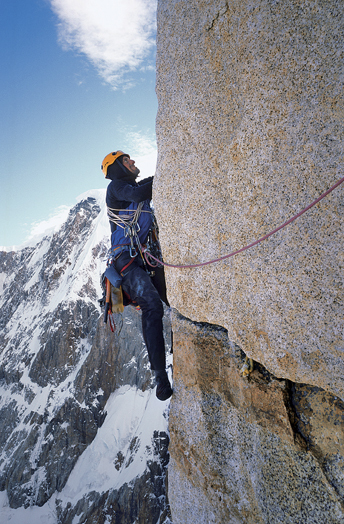Cerro Torre Massif, Enchainment, and Cerro Standhardt, New Route. On
January 4 Stephen Koch and I went to our base camp at Laguna Torre. Our
original objective was to combine the Marsigny-Parkin Route with the
Ferrari Route to the summit of Cerro Torre. At the Norwegos Camp we met
Dean Potter, who was waiting for better weather so he could BASE jump
from Cerro Torre. I invited him to join us. The conditions on the
Marsigny-Parkin Route were not good, so we switched to our second
option: an enchainment.

Dean Potter on the Compressor Route’s Banana Crack during the enchainment of El Mochito, El Mocho and Cerro Torre. Potter, Marko Prezelj and Stephen Koch completed the 2000-meter linkup in thirty-one hours, taking an additional nine to descend. Potter carried a nine-pound parachute with him on both the initial attempt (which ended at the Col of Patience) and the successful climb, only to find that Cerro Torre is not steep enough for BASE jumping. [Photo] Marko Prezelj
On January 17 we started from the glacier up El Mochito (ca. 250m) via
new ground (6a max.) and then joined the Piola-Anker Route to reach the
top of El Mocho. We used a single rope; the leader climbed without a
pack (but with all his personal and climbing equipment on his harness)
and the two seconds carried packs with a little bivy gear, some food and
their own climbing equipment. Moving fast, we began to rappel down the
north side of El Mocho around midday as the weather turned to wind and
rain. After approximately 150 meters of rappels, we headed up the snow
and ice slopes toward the Col of Patience. Once we’d seen a large
wind-slab avalanche nearby, we became more careful. The crux of this
section was a steep mixed pitch, with wet snow and rotten ice, some 150
meters below the Col of Patience. It took me almost an hour to free
climb it, and I took a fall on the exit slab–my only lead fall in the
mountains in the last ten years.
We reached the Col of Patience in more wind and rain, then spent an
uncomfortable, wet, cold night in a snow crevasse before descending in
the morning. As we rested the next day in Norwegos, the weather turned
windy and sunny, perfect for drying our equipment and reigniting our
motivation.
January 20 we began again with the same idea and the same tactics. We
reached the Col of Patience at 1 p.m., where we rested and prepared some
water before continuing up the Compressor Route. Complete darkness fell
on us two pitches under the Ice Towers. After midnight we dug out a
small ledge in an ice bridge under the headwall, that infamous monument
to bolting. At first light we followed the bolts to reach the windy
summit in the early afternoon. Dean decided that it was not steep enough
for a safe BASE jump and joined us on a ten-hour rappel of the
Compressor Route; we arrived back at Norwegos in the evening.
The next day, as the weather deteriorated again, we descended to
Chalten. The weather continued to be unsettled for the following
week. While Dean waited for his wife, Steph Davis, Stephen and I went up
to Norwegos on January 29, just a few days before our flight home. On
Cerro Standhardt (2800m) we discovered an interesting new line on the
bottom half of the east face. The next dawn we started to climb the rock
buttress just left of the Tomahawk route, finding steep cracks and
logical passages. From the end of the eighth pitch, we rappelled fifteen
meters into a deep, mixed chimney. It was late in the afternoon and a
small waterfall was running over the steepest section where the ice was
thin and rotten. At the top of the chimney, we were lucky enough to
catch the last half hour of sun in order to dry a little; there we
waited until 3 a.m. for the temperatures to drop and the ice to improve.
In the dark, windy and somewhat foggy morning, we missed the start of
the Exocet chimney, but soon we found the right way to the summit ridge.
Although we now had wind, clouds and some rain, the cold kept the ice in
place. One short rock pitch brought us to the summit snow and ice, and
two more ropelengths to the base of the thirty-meter summit mushroom.
Since it had poor snow conditions on the second half, it took me almost
an hour to reach the actual top at about 3 p.m., February 1.
The descent, with only two days before our flights home, was a story in
its own right. After about eight full rappels, our climbing rope stuck,
and when its tattered condition caused it to give out, we had to climb
back 150 meters to a couloir with an easier way down. Many thirty-meter
rappels got us to Norwegos at approximately 4 a.m. We could afford only
four hours of sleep before we had to pack and head to our base camp
where we had left the rest of our gear. Around 10 p.m. Don Guerra
finally sent the horses up, and we got our bags down around 2 a.m. Five
hours later we had made the bus for Calafate and were on our way to the
airport.
Marko Prezelj, Kamnik, Slovenia